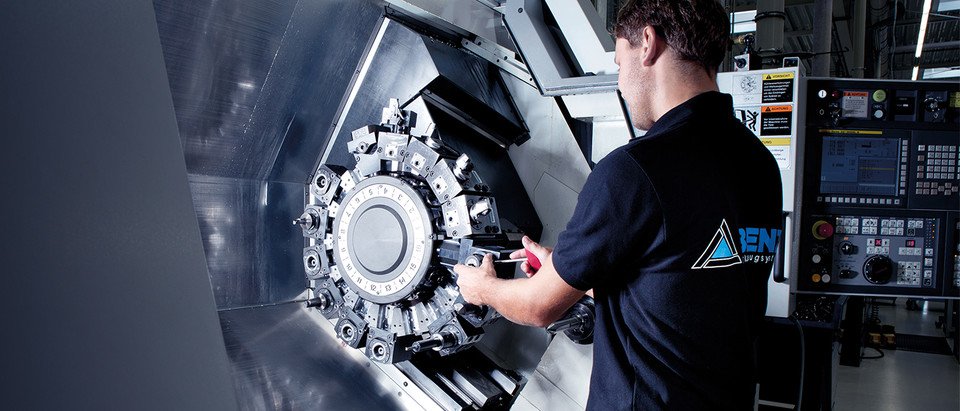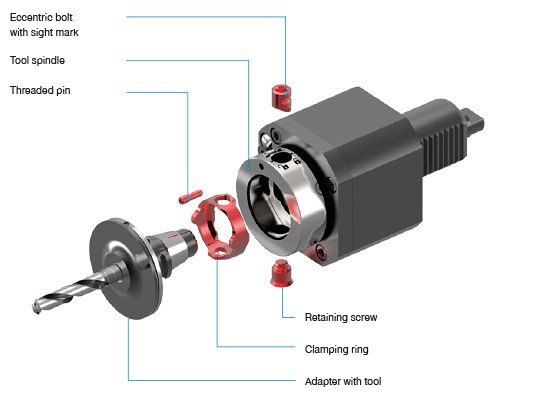 Many machine shops are losing tens of thousands of dollars in company profits each year by not implementing quick-change tooling on mills and lathes. Implementing this technology can easily reduce downtime an hour a day.
Many machine shops are losing tens of thousands of dollars in company profits each year by not implementing quick-change tooling on mills and lathes. Implementing this technology can easily reduce downtime an hour a day.
While many quick-change tooling is used on CNC turning centers, there are a lot of applications where quick-change tooling should also be considered for angle heads on machining center applications. General manufacturing, aerospace, defense, automotive and heavy equipment manufacturing all have the need for set-up reduction along with fast broken and worn tool replacement.
Quick-change tooling will determine the earning potential of a new machine because quick-change tooling can improve productivity resulting in increased production and higher company profits.
For instance, quick-change tooling can reduce set up times. Unless a company is running high production, a company can leave the tools mounted in the turret, and change only the preset adapters, set ups can be reduced by 1-2 hours.
 On low-production applications, the turret index time is not as important as set-up reduction. A company is most likely to finish the production run in less time than it takes to set-up the lathe. The focus must be set-up reduction.
On low-production applications, the turret index time is not as important as set-up reduction. A company is most likely to finish the production run in less time than it takes to set-up the lathe. The focus must be set-up reduction.
In terms of fast broken and worn tool replacement, preset adapters can be replaced in 15 seconds instead of 3-10 minutes per tool. Tool presetting is done off the lathe saving 2 minutes per tool compared to using the lathe presetter. Tool replacement is often done by someone other than the operator. Downtime waiting on this person is time consuming and costly.
Static and live tools
In addition, quick-change applies to both static and live tools. Do not exclude the static tools when considering quick-change. Turning, threading, grooving and cutoff tools seldom change but do need inserts replaced. More common need for quick-change on static tools are the boring bars, reamers, drills and taps. They change with every set-up.
These devices lower the cost of tooling as you do not need tools with dedicated spindles. Tools with mill arbor, Weldon, whistle notch, different size and style of collet chucks, etc. are too costly to have on hand for usage once or twice a year.
The quick-change tooling provides safety to the turret. Manufactures say not to change the tool in the collet in the lathe in any position other than the driven position because it can cause damage to the inside of the turret. Quick-change lowers risk of maintenance, tools can be changed in any turret position as there are no forces passed to the tang to damage the inside of the turret.
It also provides safety to the operator. Adapters can be exchanged safely with one hand and there is no risk of a collet wrench slipping off the tool and the operator getting injured from adjacent tooling as the quick-change adapters are assembled and preset outside the lathe.
There is no risk of injury when the operator reaches into large lathes. Tools are heavy and reaching into large lathes to install the tool in the turret can cause the operator to lose balance creating a high risk for injury.
It also lowers the need for capital spending on additional machinery and allows a company to increase productivity on existing machinery first.
Most of the time operator safety, machine tool safety and lower capital spending are not talked about. Customers are surprised to find out these are additional advantages to purchasing quick-change tools. All three should be considered as they will greatly enhance the need and payback of the quick-change tooling.
Benz’ Solidfix system
In 2012 BENZ introduced BENZ Solidfix a 15-second quick-change tooling system to be implemented with the company’s live tools, static tools and angle heads. Solidfix can be quick-changed in the same time (15 seconds) as competing products for about 30% less.
To determine how much Solidfix quick-change can help a company can be answered with a cost justification worksheet and an App that can be downloaded to a phone to help customers understand savings derived from set-up reduction and worn or broken tool replacement. The savings calculated and the opportunity for increased production/profit showed the quick-change payback was less than 6 months, resulting in increased profits the first and every year thereafter.
Whether buying the quick-change tooling at the time of the lathe or angle head purchase, it is never too late to integrate quick-change tooling, and increase company profits!
Implementation of quick-change tooling will require some new procedures. Don’t let this get in the way of your decision. This is not a choice; it is your profit we are talking about! Just like anything else, training and procedures are required to maximize your investment.
For more information on quick-change tooling, contact [email protected].
Contact Details
Related Glossary Terms
- arbor
arbor
Shaft used for rotary support in machining applications. In grinding, the spindle for mounting the wheel; in milling and other cutting operations, the shaft for mounting the cutter.
- boring
boring
Enlarging a hole that already has been drilled or cored. Generally, it is an operation of truing the previously drilled hole with a single-point, lathe-type tool. Boring is essentially internal turning, in that usually a single-point cutting tool forms the internal shape. Some tools are available with two cutting edges to balance cutting forces.
- centers
centers
Cone-shaped pins that support a workpiece by one or two ends during machining. The centers fit into holes drilled in the workpiece ends. Centers that turn with the workpiece are called “live” centers; those that do not are called “dead” centers.
- collet
collet
Flexible-sided device that secures a tool or workpiece. Similar in function to a chuck, but can accommodate only a narrow size range. Typically provides greater gripping force and precision than a chuck. See chuck.
- computer numerical control ( CNC)
computer numerical control ( CNC)
Microprocessor-based controller dedicated to a machine tool that permits the creation or modification of parts. Programmed numerical control activates the machine’s servos and spindle drives and controls the various machining operations. See DNC, direct numerical control; NC, numerical control.
- cutoff
cutoff
Step that prepares a slug, blank or other workpiece for machining or other processing by separating it from the original stock. Performed on lathes, chucking machines, automatic screw machines and other turning machines. Also performed on milling machines, machining centers with slitting saws and sawing machines with cold (circular) saws, hacksaws, bandsaws or abrasive cutoff saws. See saw, sawing machine; turning.
- grooving
grooving
Machining grooves and shallow channels. Example: grooving ball-bearing raceways. Typically performed by tools that are capable of light cuts at high feed rates. Imparts high-quality finish.
- lathe
lathe
Turning machine capable of sawing, milling, grinding, gear-cutting, drilling, reaming, boring, threading, facing, chamfering, grooving, knurling, spinning, parting, necking, taper-cutting, and cam- and eccentric-cutting, as well as step- and straight-turning. Comes in a variety of forms, ranging from manual to semiautomatic to fully automatic, with major types being engine lathes, turning and contouring lathes, turret lathes and numerical-control lathes. The engine lathe consists of a headstock and spindle, tailstock, bed, carriage (complete with apron) and cross slides. Features include gear- (speed) and feed-selector levers, toolpost, compound rest, lead screw and reversing lead screw, threading dial and rapid-traverse lever. Special lathe types include through-the-spindle, camshaft and crankshaft, brake drum and rotor, spinning and gun-barrel machines. Toolroom and bench lathes are used for precision work; the former for tool-and-die work and similar tasks, the latter for small workpieces (instruments, watches), normally without a power feed. Models are typically designated according to their “swing,” or the largest-diameter workpiece that can be rotated; bed length, or the distance between centers; and horsepower generated. See turning machine.
- machining center
machining center
CNC machine tool capable of drilling, reaming, tapping, milling and boring. Normally comes with an automatic toolchanger. See automatic toolchanger.
- milling machine ( mill)
milling machine ( mill)
Runs endmills and arbor-mounted milling cutters. Features include a head with a spindle that drives the cutters; a column, knee and table that provide motion in the three Cartesian axes; and a base that supports the components and houses the cutting-fluid pump and reservoir. The work is mounted on the table and fed into the rotating cutter or endmill to accomplish the milling steps; vertical milling machines also feed endmills into the work by means of a spindle-mounted quill. Models range from small manual machines to big bed-type and duplex mills. All take one of three basic forms: vertical, horizontal or convertible horizontal/vertical. Vertical machines may be knee-type (the table is mounted on a knee that can be elevated) or bed-type (the table is securely supported and only moves horizontally). In general, horizontal machines are bigger and more powerful, while vertical machines are lighter but more versatile and easier to set up and operate.
- tang
tang
Extended flat portion of tapered drill shank, endmill or other tool that allows maximum power transmission and proper positioning of the tool. Reverse shape of the machine-spindle slot into which it fits.
- threading
threading
Process of both external (e.g., thread milling) and internal (e.g., tapping, thread milling) cutting, turning and rolling of threads into particular material. Standardized specifications are available to determine the desired results of the threading process. Numerous thread-series designations are written for specific applications. Threading often is performed on a lathe. Specifications such as thread height are critical in determining the strength of the threads. The material used is taken into consideration in determining the expected results of any particular application for that threaded piece. In external threading, a calculated depth is required as well as a particular angle to the cut. To perform internal threading, the exact diameter to bore the hole is critical before threading. The threads are distinguished from one another by the amount of tolerance and/or allowance that is specified. See turning.
- turning
turning
Workpiece is held in a chuck, mounted on a face plate or secured between centers and rotated while a cutting tool, normally a single-point tool, is fed into it along its periphery or across its end or face. Takes the form of straight turning (cutting along the periphery of the workpiece); taper turning (creating a taper); step turning (turning different-size diameters on the same work); chamfering (beveling an edge or shoulder); facing (cutting on an end); turning threads (usually external but can be internal); roughing (high-volume metal removal); and finishing (final light cuts). Performed on lathes, turning centers, chucking machines, automatic screw machines and similar machines.

